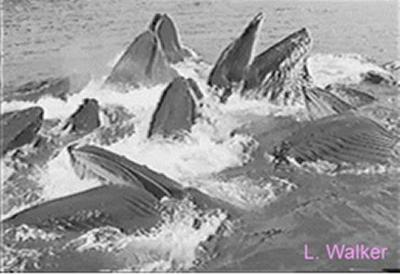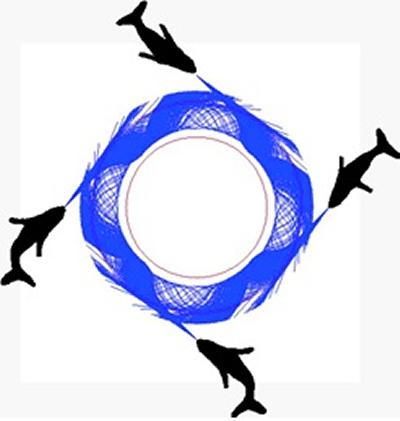
Whales hunting with a wall of sound
Click here for articles on this by journalists and the public, on TV, radio and the web.
How whales use bubble nets to hunt prey.
Background
It had been known for some time that humpback whales use bubble nets to hunt prey. The whales dive deep, swim in a spiral, and blow a wall of bubbles. The wall encircles the prey, who do not cross the wall, and so are trapped, forming a convenient meal for the whales as they swim up from below, mouths agape.

What was the discovery?
There had never been a satisfactory explanation as to why the prey did not leave the net. Professor Leighton (Southampton University) proposed that, if the whales emitted a particular frequency range when feeding, the sound could be trapped in the bubbly curtain, making a ‘wall of sound' that the prey would not cross.

Indeed, when he finally did find a recording of the particular call made by the whale when hunting with a bubble net, the frequencies used were correct. Computer models showed that sound could indeed be trapped in the net (see the ray path model on the right).
In using sound in this way, whales would be turning the survival instinct of fish (to form tight schools when startled) into an ‘anti-survival' instinct that got them eaten!. Furthermore, if the species of fish within the net had swim bladders (as many do), the frequencies of the call would resonate the swim bladders, making it particularly uncomfortable for any fish that tried to cross the bubbly ‘wall of sound'.
Not the end of the story? However Professor Leighton was not satisfied because to trap sound in a circular bubble net required:
The problems arose because the modelled net was circular, based on the literature he had read on reporting such nets as being circular. Searching further, he found photographs showing different geometries, the most common being spiral. This was an interesting find, since he realised that the bell-like opening of a spiral allow the net to capture sound from a wide range of angles, meaning the whale did not have to aim so precisely as with a circular net. Furthermore, the presence of a bubble-free arm to the spiral (trapped between bubbly arms) meant that the absorption of the sound by bubbles was not such a problem.
In the ray tracing pictures of the net shown on the right, the bubble-free areas are shown in white, with the bubble concentration increasing as the shading gets darker. The picture on the left (a) shows one ray entering the net through the bubble-free ‘horn', and bouncing off the bubbly walls of the spiral at A, B, C, D etc. The distance between bounces gets smaller as they progress, as does the grazing angle of the ray, because of the spiral geometry. The picture on the right (b) shows the paths of many rays released into the horn, showing how the ray paths (of the type shown in (a)) all work to create a quiet zone where the prey can be trapped.
The original publications can be found are the sites below (click on the author names to download a copy):
The original paper on circular nets: Leighton, T.G., Richards, S.D. and White, P.R. (2004) Trapped within a 'wall of sound': A possible mechanism for the bubble nets of the humpback whales, Acoustics Bulletin, 29(1), 24-29
The follow-up paper on spiral nets: Leighton, T.G., Finfer, D., Grover, E. and White, P.R. (2007) An acoustical hypothesis for the spiral bubble nets of humpback whales and the implications for whale feeding, Acoustics Bulletin, 22(1), 17-21

Click here for articles on this by journalists and the public, on TV, radio and the web.


Radio clips:
BBC Radio 4 (February 12 2004) "Leading Edge"; clip
BBC World Service (March 24 2004) "Discovery"; clip
Radio City, Ecuador (a joint association between "El Universo", the biggest newspaper in Ecuador, and the BBC) (April 21 2004) "Buscando la Luna" ("Seeking the moon") - in Spanish
News and blog reports on this story:
BBC Online (March 25 2004) pdf
Ocean News (April 2 2004) pdf
Orca Network (March 20 2004) pdf
UoS Bulletin (Feb 2 2004) pdf
Wild - The Wildlife Magazine for Kids (November 2004) ) pdf
These findings were used in the following TV documentaries
BBC1's "Nature's Great Events: 3-The Great Feast" (narrated by Sir David Attenborough; produced by A. Fothergill) (2009);
National Geographic TV "Humpbacks: Cracking the Code" (2008)
BBC TV's CBBC (Children's BBC) ‘Deadly Top 10' (2011)
For more information on bubble acoustics click here.
Other media